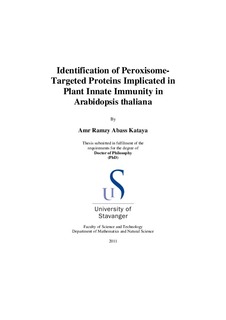| dc.contributor.advisor | Reumann, Sigrid | |
| dc.contributor.author | Kataya, Amr Ramzy Abass | |
| dc.date.accessioned | 2016-03-16T08:30:41Z | |
| dc.date.available | 2016-03-16T08:30:41Z | |
| dc.date.issued | 2011 | |
| dc.identifier.citation | Identification of Peroxisome-Targeted Proteins Implicated in Plant Innate Immunity in Arabidopsis thaliana by Amr Ramzy Abass Kataya, Stavanger : University of Stavanger, 2011 (PhD thesis UiS, no. 146) | nb_NO |
| dc.identifier.issn | 1890-1387 | |
| dc.identifier.uri | http://hdl.handle.net/11250/2382308 | |
| dc.description | Doktoravhandling | nb_NO |
| dc.description.abstract | Peroxisomes are subcellular organelles, traditionally known to be
involved in processes like photorespiration, fatty acid β-oxidation, and
detoxification of reactive oxygen species. Proteome analysis of plant
peroxisomes and targeting signal prediction methods are important
tools to identify novel peroxisomal proteins. In the present study the
accuracy of newly developed methods to predict peroxisome targeting
signals type 1 (PTS1) in plant proteins was investigated by in vivo
subcellular targeting analyses. Upon application of these prediction
methods to the Arabidopsis thaliana genome, 392 gene models were
predicted to possess functional PTS1 domains, several proteins of
which were validated as peroxisomal and numerous novel PTS1
tripeptides were identified. Furthermore, several detoxification-related
enzymes and defense-related Arabidopsis proteins were detected by
proteome analyses and PTS1 prediction methods that were potentially
targeted to peroxisomes.
Two enzymes of the ascorbate-glutathione (ASC-GSH) cycle,
glutathione reductase 1 (GR1) and dehydroascorbate reductase 1
(DHAR1), and five glutathione-S transferases (GSTs) had been
detected by proteome analysis in leaf peroxisomes. In vivo subcellular
localization targeting analyses of the present study verified peroxisomal
targeting for GR1 and the protein was found to carry a functional novel
PTS1 (TNL>). By contrast, the four GSTs remained cytosolic in the
chosen orientation in the back of the reporter protein.
New fragmented evidence has been emerging in the literature for an
important role of plant peroxisomes in innate immunity. In the present
study sixteen defense-related Arabidopsis proteins were experimentally
investigated for protein targeting to peroxisomes by in vivo subcellular
localization. The proteins of interest included several yet unknown
homologs of Arabidopsis NDR1 and tobacco HIN1, the so-called
NDR1/HIN1 like (NHL) proteins. In vivo subcellular localization was
primarily investigated for three NHL family members (NHL4, NHL6
and NHL25). Peroxisome targeting was verified for NHL4 with strong
indications also for NHL6 and NHL25 in being located in peroxisomes.
AtIAN12 is a homolog of AIG1/AtIAN8 and had been identified by
Arabidopsis leaf peroxisome proteomics. In vivo subcellular
localization experiments demonstrated that AtIAN12 protein is targeted
to peroxisomes and indicated that the targeting pathway involves posttranslational
protein modification by isoprenylation. Taken together,
the data indicate for the first time that one NDR1/HIN1 homolog
(NHL4) and AtIAN homolog (AtIAN12) are peroxisome associated.
Preliminary gene expression analyses indicated that three NHL genes
and three AtIAN genes are induced by a bacterial pathogen (Pst
DC3000), while NHL6, NHL25, and AtIAN8 are induced by an
avirulent Pst DC3000 strain (carrying the effector avrRpt2). Out of the
six NHL and AtIAN genes, only NHL6 appeared to be induced in wt
Col-0 plants by the bacterial elicitor (flg22), but remained unaffected in
Arabidopsis plants carrying a mutation in the flagellin receptor gene
FLS2. The data suggested that NHL6 is involved in basal PAMP
triggered immunity (PTI). Furthermore, NHL6 transcripts accumulated
similarily in both wt plants and npr1 mutant plants after flg22
treatment, which indicates that NHL6 induction is NPR1-independent.
Functional studies were initiated through the isolation of homozygous
mutants, amiRNA lines and overexpresser lines for selected NHL and
AtIAN genes. In homozygous mutants (three nhl mutants and ian11),
differences in bacterial proliferation were observed compared to wt
plants upon infection with the avirulent bacterium Pst DC3000
(avrRpt2). Overall, the identification of several defense-related proteins
in peroxisomes together with preliminary functional data on NHL
proteins opens new perspectives to important, multi-layered
peroxisome functions in plant innate immunity. | nb_NO |
| dc.language.iso | eng | nb_NO |
| dc.publisher | University of Stavanger, Norway | nb_NO |
| dc.relation.ispartofseries | PhD thesis UiS;146 | |
| dc.relation.haspart | LINGNER, T., KATAYA, A.R., ANTONICELLI, G.E., BENICHOU, A., NILSSEN, K., CHEN, X.Y., SIEMSEN, T., MORGENSTERN, B., MEINICKE, P. & REUMANN, S. (2011) Identification of Novel Plant Peroxisomal Targeting Signals by a Combination of Machine Learning Methods and in Vivo Subcellular Targeting Analyses. Plant Cell, 23, 1556- 1572. | nb_NO |
| dc.relation.haspart | KATAYA, A.R.A. & REUMANN, S. (2010) Arabidopsis Glutathione Reductase 1 Is Dually Targeted to Peroxisomes and the Cytosol. Plant Signal Behav, 5:2, 171-175. | nb_NO |
| dc.rights | Copyright the author, all right reserved | |
| dc.rights | Navngivelse 3.0 Norge | * |
| dc.rights.uri | http://creativecommons.org/licenses/by/3.0/no/ | * |
| dc.subject | peroxisomer | nb_NO |
| dc.subject | subcellulære organeller | nb_NO |
| dc.subject | enzymer | nb_NO |
| dc.title | Identification of Peroxisome-Targeted Proteins Implicated in Plant Innate Immunity in Arabidopsis thaliana | nb_NO |
| dc.type | Doctoral thesis | nb_NO |
| dc.subject.nsi | VDP::Mathematics and natural science: 400::Zoology and botany: 480::Plant physiology: 492 | nb_NO |

